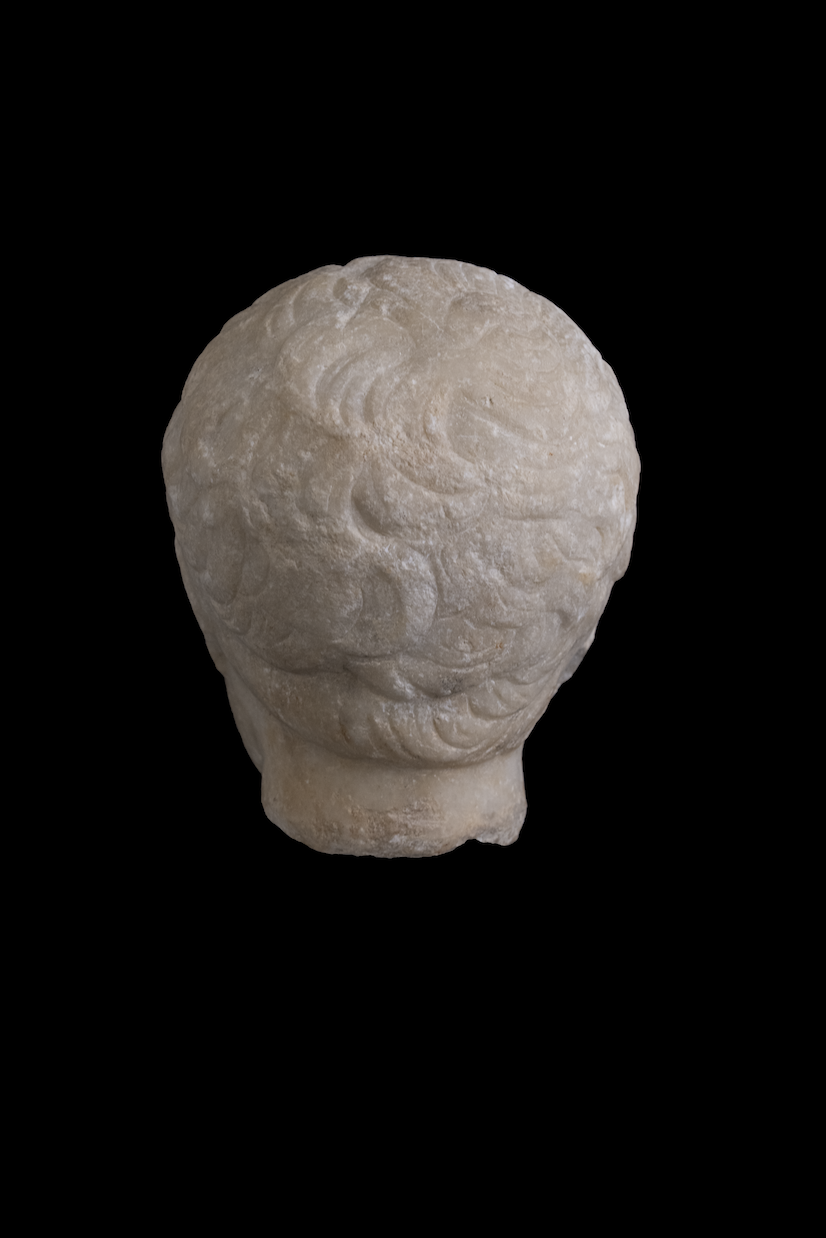Portrait head of a young boy
Category
HeadsAbout This Artefact
I.D. no: 48949
Dimensions: Max. H. 16 cm; Max. W. 13 cm.
Material: Medium-grain white marble with some greyish streaks of various thickness.
Provenance: Unknown.[1]
Current location: National Museum of Archaeology
Condition: The head is broken off more or less horizontally just below the chin, but a further large break has shorn off the lower left part of the face, from the left cheek to the chin, including the left part of the lower lip. The tip of the nose is also missing. Other minor chips are noted on the right ear, forehead and right cheek. The whole surface of the marble appears to be somewhat worn, flattening features like eyes and ears. A modern circular hole was bored into the bottom surface of the neck break for fitting into a stone base.
Description: This is the head of a smiling child of about 5-6 years with a high forehead, rounded cheeks and short, curly hair. The face is turned slightly to its left while the head shows a slight inclination to its right. The hair departs from the apex of the head with a helical pattern and flows forward and down the back in four overlapping layers of low but rather thick locks. The high and rather narrow forehead shows slight swellings on the temples and the outer eyebrows. The somewhat elongated eyes, together with the movement of the mouth and full cheeks emanate a gentle smiling expression. The tear ducts and the outer corners of the mouth display distinctly drilled holes.
Discussion: There is a certain air about this head, produced by its lively movement in turning to one side, and by its playful smile, which echoes types of Erotes, putti and young satyrs created and widely diffused in the Hellenistic period.[2] The smile and the hair treatment remind one also of a number of similar smiling heads of the so-called ‘temple girls’ from the temple of Eshmun at Sidon, dated to the middle or second half of the fourth century BC.[3]
There is no doubt, however, that this head is a child’s portrait and belongs to Roman art of the first century or first quarter of the second century AD at the latest.[4]
Portraits of young children such as this, expressed with a sober realism, are quite common in the first century AD, especially among the Julio-Claudian family portraits.[5] Much less common is the joyful smile for which this head can be compared to an extensively damaged portrait of a very young boy from Smyrne, now in the Izmir Museum, dated to the first quarter of the 2nd century.[6] The shape of the head and the eyes, as well as the hairstyle, appear to be very similar. It has been noted that such smiling children seem to be more frequent in Egypt than elsewhere,[7] but several other examples occur in Italy and elsewhere.[8]
An almost identical head in the Magazzino of the Vatican Museum, dated to the Hadrianic age, might suggest that both it and the Maltese specimen are both portraits of children of the imperial family.[9] Had the portrait been found in the Roman domus of Rabat, we would have been tempted to suggest a fit with the togate statue of a boy from that building (I.D. no. 15887), but the age of the boy portrayed by that statue must have been substantially older (around 13 years of age) and the hairstyle of the present head does not seem to fit in a Julio-Claudian context.
A head in Fulda, tentatively identified as an Antonine prince, seems to have the same features, but is of a boy some four years older.[10] The similarity in the hairstyle in a head from the theatre in Leptis Magna reaffirms the probability of a Hadrianic date for the Valletta head.[11]
Bibliography: (previous publications of item):
Zammit 1919: 25. Zammit 1931: 15. Bonanno 1971: 143-147.
[1] Its exclusion from the lists of sculptural pieces in Ashby 1915 suggests a post-1915 acquisition by the Museum Department. A search in the sections dedicated to ‘acquisitions’ and ‘donations’ in the Annual Reports of the Museum Department for 1910-1920 did not yield any significant mention. Zammit’s ‘Head of youth, provenance unknown’ (1919: 25), and ‘Head of youth, of unknown origin’ (1931: 15) might possibly refer to it.
[2] Bieber 1961: figs. 285, 544-7, 564-70, 581-3; Klein 1921: passim, especially 27-59. The absence of the incised irises and pupils tends to exclude a date after the reign of Emperor Hadrian.
[3] Stucky1993: nos. 186, 198-211.
[4] For a detailed study of child portraiture in this period see Gercke 1968. The study includes catalogues of children’s portraits, both in relief and in the round, in which the Maltese head and some examples cited herein do not appear.
[5] Gercke 1968: passim, especially pp. 176-8 (bibliography in notes 831-4); Amedick 1991; Boschung 1993; Rose 1997.
[6] Inan and Rosenbaum 1966: 117, no. 128, pl. 76, 3-4.
[7] Graindor [1937]: 107-8, no. 51, pl. 43 (previous bibliography in note 416)
[8] Giuliano 1957: no 39, pl. 23; Kaschnitz-Weinberg 1936-37: pl. 71 (several examples). Some similarities in the eyes, mouth, faint smile and hair frame are noted in the portrait of a ‘Flavian Prince’ in the Ny Carlsberg Glyptotek, Copenhagen, but only from the front: Poulsen 1974: 50-1, no. 16, pl. 30. The Danish portrait has a thicker hair mass at the back and wears a wreath of leaves. Bergmann has questioned its portrait qualities (see Johansen 1995: 56-7, no. 16).
[9] Kaschnitz-Weinberg 1936-37: 169, no. 368, pl. 71 (the marble, the dimensions and the turn of the head are also similar). For the problem of child portraits from Flavian to Hadrianic times see Gercke 1968: 178.
[10] Von Heintze 1968: 56-7, no. 38, pl. 125.
[11] Caputo & Traversari 1976: 91, no. 69, pl. 71.




